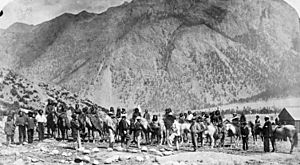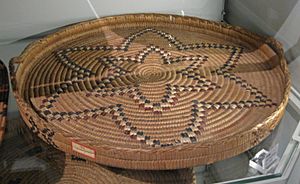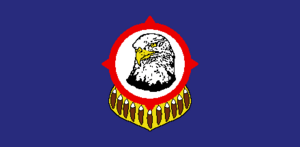Stʼatʼimc facts for kids
 |
|
| Total population | |
|---|---|
| 6,260 approx. | |
| Regions with significant populations | |
| Languages | |
| English, Stʼatʼimcets | |
| Religion | |
| Christianity, Animism, other | |
| Related ethnic groups | |
| other Interior Salish-speaking peoples |
The Stʼatʼimc people, also known as the Lillooet, are an Indigenous group living in the southern Coast Mountains and Fraser Canyon areas of British Columbia, Canada. Their culture shares many features with other Northwest Coast peoples. These include traditions like the potlatch, special clan names, and rich stories (mythology). Some communities even had totem poles.
Today, there are about 6,259 Stʼatʼimc people. They have a deep connection to their land and traditions.

Contents
Who are the Stʼatʼimc People?
The Stʼatʼimc are divided into two main groups. These groups are different in their language, culture, and where they live.
- The Upper Stʼatʼimc (also called Upper Lillooet) live near the city of Lillooet on the Fraser River. They call themselves STLA'tlei-mu-wh-talk. They speak a dialect of the Stʼatʼimcets language.
- The Lower Stʼatʼimc (also called Lower Lillooet) live near Mount Currie. This area is in the Pemberton Valley. They call themselves LEEL'-wat-OOL, which means 'The true People'. The words 'Lillooet' and 'Lilwat' come from this name. They speak the Ucwalmícwts dialect.
- The Lakes Lillooet are a smaller group. They live between the Upper and Lower Stʼatʼimc territories. Their homes are around Seton Lake and Anderson Lake. Today, their descendants are the N'quatqua First Nation and the Seton Lake First Nation.
Lower Stʼatʼimc Communities
The Lower Stʼatʼimc include several communities:
- The Lil'wat First Nation has a large traditional territory. It stretches from Rubble Creek in the south to just below Anderson Lake in the north. Their main community is Mount Currie.
- The Xa'xtsa First Nation has two communities. These are Port Douglas and Tipella. Tipella is their main community. It is on the west side of the Lillooet River.
- The Skatin First Nations live at Skookumchuck Hot Springs on the Lillooet River. This community was once very large. It was similar in size to the old village at Mount Currie.
- The Samahquam First Nation returned to their lands in the 1990s. They built the Baptiste Smith community. This is at the southwest end of Little Lillooet Lake.
Some of these smaller communities, like Samahquam, Xa'xtsa, and Ska'tin, joined together. They formed the In-SHUCK-ch Nation. They call themselves Nsvq’tsmc. This name comes from a holy mountain called In-SHUCK-ch Mountain.
Upper Stʼatʼimc Communities
The Upper Stʼatʼimc lived west of the Fraser River. Their land went from Pavilion Creek to the Bridge River area. East of the Fraser River, their territory included the Three Lake Valley. This area stretched towards Hat Creek.
The Upper Stʼatʼimc built many main settlements. These were on the banks of the Fraser River and Seton and Anderson Lakes. Some important communities were Sk'ámqain, Satʼ, Nxwísten, and Xáxlip. There were also many smaller villages.
Today, the Upper Stʼatʼimc include:
- N'quatqua in D'Arcy. This community is at the head of Anderson Lake.
- Tsaľálh (Shalalth), Skeil, Ohin, Lh7us (Slosh), and Nquayt (Nkiat). These communities are along Seton Lake. They are all part of the Seton Lake First Nation.
- Sekw'el'wás in Lillooet.
- Tʼítʼq'et in Lillooet.
- Nxwísten in Lillooet (the Bridge River Indian Band).
- Cácl'ep near Lillooet (the Fountain Indian Band).
- Tsk'weylecw (the Pavilion Indian Band) at Pavilion. This area is between Lillooet and Cache Creek.
Stʼatʼimc History and Way of Life
The Stʼatʼimc people had different types of homes. They used long plank houses, winter earthlodges, and summer lodges made of bark or mats.
Their economy was based on salmon and other fish. They also hunted animals like bear, sheep, and deer. Berries and fruits were gathered too. They usually traded with other groups. Warfare was not common.
However, there was a tough war with the Tsilhqot’in people. This war threatened the Stʼatʼimc. The Tsilhqot’in raided Stʼatʼimc communities and took women and children as slaves. The Stʼatʼimc won a big battle in their territory. Chief In-Kick-Tee (Hunter Jack) was their war chief. He made a peace treaty in 1845.
The 1911 Declaration of the Lillooet Tribe
The declaration of the Lillooet Tribe was made in 1911. It was a formal statement about their land. Non-native settlers had taken some of their lands. The Declaration stated that the Stʼatʼimc people owned all their traditional territories.
This Declaration is very important. It is the basis for many of the Stʼatʼimc organizations today. These include the Stʼatʼimc Chiefs Council and the In-SHUCK-ch Nation. The Declaration helped bring the tribe together.
Stʼatʼimc Language
The traditional language of the Stʼatʼimc people is Lillooet. It is also called Stʼatʼimcets. This language is part of the Interior Salish group. Other languages in this group include those of the nearby Secwepemc and Nlaka'pamux peoples.
Images for kids
See also
 In Spanish: Lillooet para niños
In Spanish: Lillooet para niños



